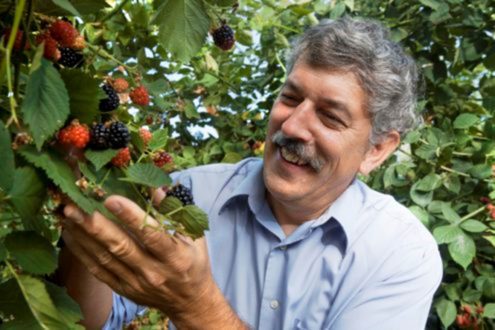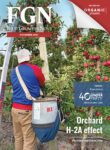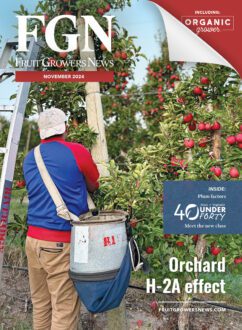Jan 10, 2023Soil solutions: tips for strawberry growers take center stage
After conducting more than 20 years of perennial strawberry soil health research, Marvin Pritts has identified strategies for growers who produce the finicky plants.
Pritts, director of undergraduate studies for the SIPS Horticulture Section at Cornell University, spoke at the Great Lakes Fruit, Vegetable & Farm Market EXPO in December in Grand Rapids, Michigan.
Characteristics of healthy soils, which can be determined with a soil test, include good tilth, sufficient (but not excess) nutrients, good water storage and drainage.

“Chemical components of soil are just one-third of what makes plants grow well,” Pitts said. “The other parts are the physical and biological properties of the soil.
“In general, strawberry fields’ soil are not doing that great,” he said when comparing strawberries to other tested crops tested at Cornell. “Soil from strawberry fields was less healthy than soils from other fields we get in, including field crops and other vegetables. Strawberry field soils showed low organic matter, active carbon and potentially mineralizable nitrogen in the tests.”
Symptoms of poor soil health show patchy patterns with complete blackening of the main/perennial roots and deterioration of perennial and feeder roots, all leading to a smaller root system. Field symptoms include the above-ground structure being stunted, reddened or collapsing, leading to a lack of runnering and a decline in vigor and productivity.
Researchers identified 27 strawberry fields in New York that have problems with poor soil health. They compared good and bad soil areas on those farms. Variables included cultural, historical, physical and chemical features in each of the soil samples.
Grower practices, the history of the site, and the physical properties, including the compaction and chemical soil tests, were evaluated. The factors that most highly correlated with poor root health included the age of the plantings, cumulative years of strawberry production, soil compaction, fine soil texture (clay), absence of raised beds, high application rates of terbacil, non-use of metalaxl and the frequency of fumigation.
“These factors, especially when co-occurring, create an environment favorable for the proliferation of disease-causing organisms,” he said.
Fumigation may not be beneficial in perennial strawberries.
“We found that the more growers fumigated the poorer the soil health was. You do have better soil the year after fumigation, but in subsequent years on perennial strawberries it’s actually worse.
“When you fumigate, you’re killing all beneficials. You’re killing the bad guys, too. But then, there’s nothing to compete with the bad guys in the odd years. They come on raging in that second and third year than they did if you wouldn’t have done anything.”
The common pathogens causing poor soil health in strawberries include Pratylenchus penetrans (nematode), Rhizotonia spp and Pythium spp. Other associated organisms are Verticillium albo-atrum, Fusarium spp., Cylindrocarpon spp., Phytopthora spp., Idriella lunata and others.
Various varieties of strawberries have different levels of resistance to these pathogens.
“That makes it really hard to generalize that this or that variety is resistant, or this pathogen is causing the disease,” Pitts said. “It’s just so complex and lead to challenges in diagnosis and management.”
These species are often isolated from healthy root systems. They can occur together and behave synergistically. Genetic differences in tolerance exist, but ratings of cultivar resistance vary depending on the location of the study.
Strategies to manage biological factors include:
*Eliminating the pathogens with fumigation/fungicides, but is difficult to do in a perennial system.
*Preventing the introduction and proliferation of pathogens by managing the chemical and physical environment, as well as the soil biology.
*Managing the physical environment can be done by using raised beds, mulching and addressing compaction. Soil compaction may not be detrimental in the absence of pathogens, he said.
“Plant health, yield and fruit size are greatest in uncompacted soils, but in the absence of poor drainage and a virgin site, strawberries are remarkably tolerant of soil compaction (up to 1.7 g/cm3).”
Biological approaches may include tillage, cover crops, composts and soil amendments. Long crop rotations are desirable, Pritts said.
When the crop sequence is changed from continuous strawberries to the use of a cover crop the “plants do a lot better. You don’t have to fumigate. You can just rotate out with some cover crops and those plants will do well. It’s maybe not quite as good as a fumigate, but pretty close, certainly better than continuous strawberries. Doing something is better than doing nothing.
“You may not be able to cure all, but you can do a lot better simply by breaking things up and just rotating with almost anything that’s unrelated to strawberry.”
Pritts said “pre-emergent herbicides may be more problematic in young plantings than generally thought.
Researchers confirmed that raised beds almost always improve root health. Compost amendments help under most, but not all conditions.
Strawberries planted into straw residue were smaller, slower to establish, had fewer runners and lower yield the following year. Straw mulch incorporated between rows once plants are established did not impact yield the following year.
“Straw mulch may be detrimental if not decomposed prior to the planting,” Pitts said.
— Gary Pullano, FGN senior correspondent














